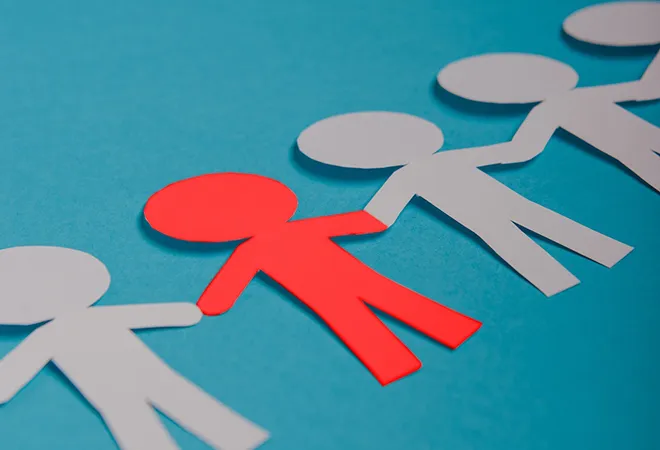
This article is part of the series — India and the World in 2021.
The global economy was dominated in 2020 by the consequences of the COVID-19 pandemic, and it will be in 2021 as well. The pandemic — hopefully — is a once-in-a-century event. Even so, the impact of the outbreak — of the lockdowns and physical-distancing that were imposed in response, and of the economic and public-health reactions from states across the world — has exacerbated various economic and geopolitical trends that already existed prior to the pandemic. The story of 2021 in the global economy will continue to be dominated by the pandemic — but examining these trends will help us understand the structures of the post-pandemic world.
The first big trend exacerbated by the pandemic is inequality.
Within countries, existing inequalities of access and incomes were worsened by the fallout of the pandemic. We heard often enough that the disease did not discriminate; in effect, it did. If you were wealthier, for example, it was easier to implement physical distancing. Older people, more susceptible to serious cases of COVID-19, could isolate themselves better when they had an existing support system and sufficient income. In countries like the United States, mortality rates were sharply higher for some ethnic minority communities.
The inequality of access to pandemic relief is revelatory of the inequality in access to basic welfare and state services even in normal times.
India’s experience — and the horrific images of tens of thousands of migrants on the march back to their villages — showed that those dependent on daily wages or the informal sector were far less able to survive. Relief packages across the world had to be pushed out through existing social security and welfare channels. These were frequently insufficient to the task, and failed to reach workers in the informal or gig economy who were most at risk. To be sure, this had nothing to do with the generosity, or otherwise sparseness of the package. The US spent so much in the CARES Act that household savings increased at points in 2021. Nevertheless, there was widespread deprivation, and in some parts of the country even food banks were overrun. The inequality of access to pandemic relief is revelatory of the inequality in access to basic welfare and state services even in normal times.
Across and between countries the pace of recovery has also been unequal: a gap that will only widen as some emerge from the worst of the pandemic well before others. Authoritarian countries like the People’s Republic of China, and democracies with high solidarity quotients like Taiwan and New Zealand, managed to control the virus early and mitigate its economic impact. Going forward into 2021, countries that will more effectively roll out the vaccine will be quicker to lift physical-distancing measures, and thus also more swiftly return to normal levels of output and income. Countries that are able to tap the global capital markets in order to enhance their government borrowing to spend more on relief will also manage the pandemic better and exit it earlier. For developing countries, these factors will set back their relative position enormously. The management of public discontent that these inequalities will produce ought to be an essential concern for policymakers.
Going forward into 2021, countries that will more effectively roll out the vaccine will be quicker to lift physical-distancing measures, and thus also more swiftly return to normal levels of output and income.
The second remarkable trend is related to the first: the salience for growth, investment and finance of ESG (environmental, social and governance) factors. States with more efficient governance structures, as already mentioned, will be able to keep income and output stable more effectively. Social systems that are more inclusive and have broad access have also responded better to the pandemic. This is cold and hard economic fact, and the coldest and hardest community in the world — international finance — has taken them on board. ESG-related fund flows defied pandemic panic to scale new heights in 2020. Environmental factors took centrestage too, as the European Union began to finance part of its relief package through green bonds.
The quality of relief and revival will be the primary object of domestic and international economic contestation over 2021. Will funds be spent on relief or on investment? Will existing “brown” — carbon-intensive — sectors be propped up in order to protect employment, or will new green sectors be supported to push growth? Will efforts be made, as in 2008, to spread stimulus across borders? Will debt restructuring and forgiveness for sovereigns take into account new economic realities, and the emergence of China as a leading creditor?
Social systems that are more inclusive and have broad access have also responded better to the pandemic. This is cold and hard economic fact, and the coldest and hardest community in the world — international finance — has taken them on board.
Which leads us to the third trend: geoeconomic competition. Existing attempts to insulate, diversify, or secure supply chains were given a particular impetus by the pandemic. The early weeks of the pandemic were harrowing, as countries discovered the degree to which they had become dependent on the People’s Republic for critical supplies. Beijing’s behaviour — early on, for example, it attempted to monopolise personal protective equipment — did not help. Subsequently, there was a dismaying rush towards economic nationalism, as countries and even provinces tried to tie up their own PPE and vaccine supplies without considering broader aims or even the health of the trading system in general. As opposed to the 2008 financial crisis, there was no attempt to create a common approach to keeping trade going.
In 2021, expect the People’s Republic to escalate its efforts to translate its relative success at controlling the pandemic into a narrative about the superiority of its economic system. There might also be increased pushback even from countries relatively dependent upon Chinese trade, such as Australia, and those that have been traditionally neutral on Beijing, such as Germany. Much depends upon what happens once Angela Merkel, a China dove, leaves office in Berlin. If other countries are wise, they will seek to expand their economic cooperation in an attempt to Beijing-proof the international trading system. Hopefully, this will be a priority for the new administration in Washington DC, without which any such efforts are doomed to fail.
On all these three trends, India is a swing state (though not perhaps a “leading player,” to use the Indian foreign minister’s formulation). If it addresses its internal disparities, produces a new welfare paradigm, and manages to become the vaccine factory for the emerging world, then the negative consequences of the first trend — inequality — will be ameliorated. If its recovery process prioritises climate-sensitive instruments, socially grounded policies and transparent, market-friendly governance reform, then the second trend will be enhanced. And if it turns its back on its misguided obsession with “aatmanirbhar” industrial policy and recommits to being a leader on new trade mechanisms, then a post-pandemic trading system will be more robust and inclusive. That is something to watch out for in 2021.
The views expressed above belong to the author(s). ORF research and analyses now available on Telegram! Click here to access our curated content — blogs, longforms and interviews.




 PREV
PREV


